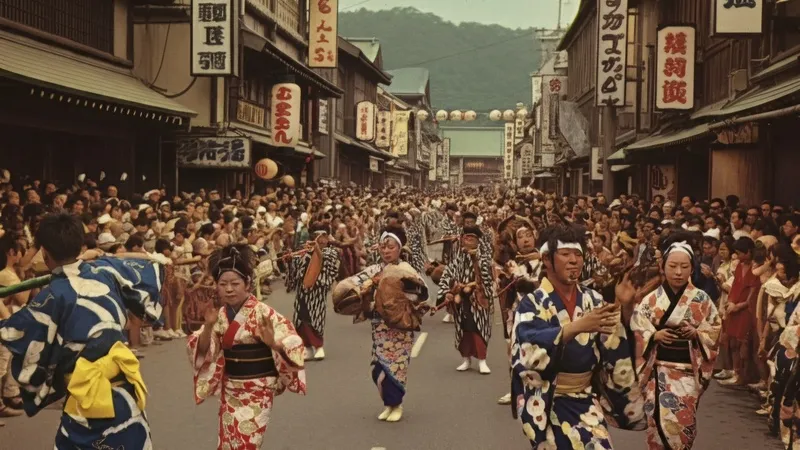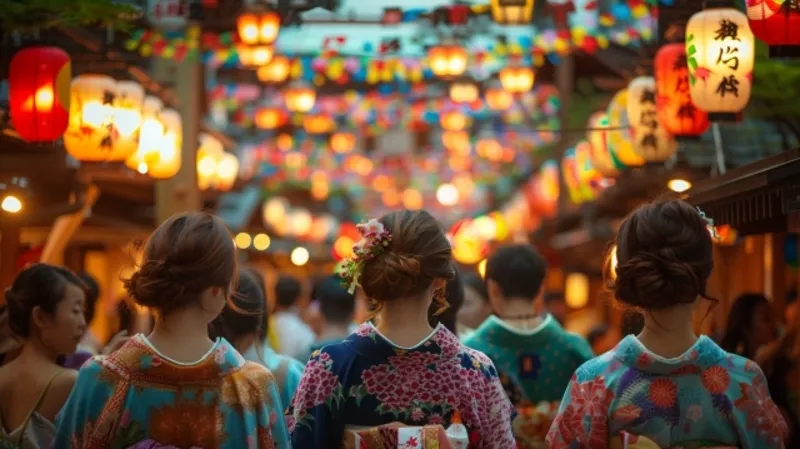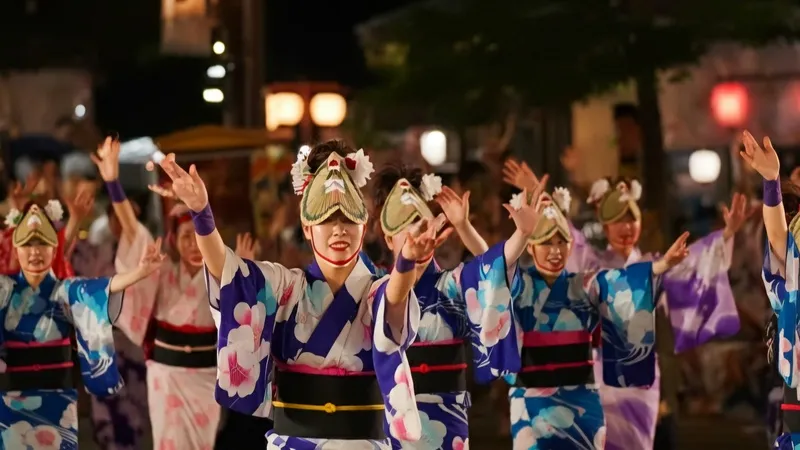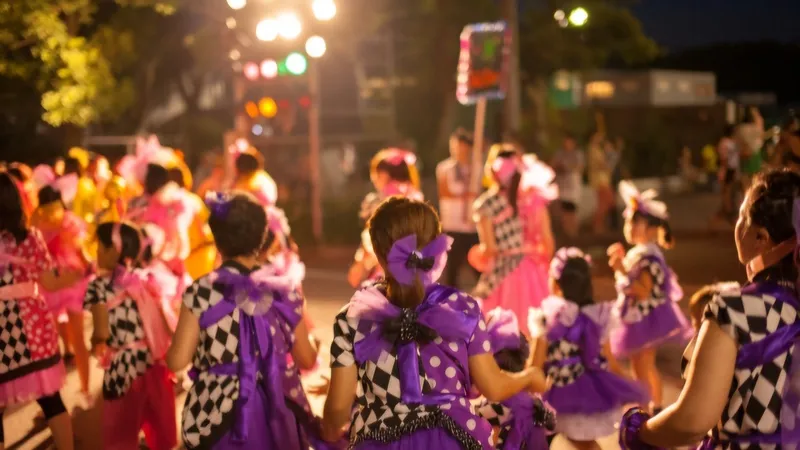The Full Appeal of Bon Dancing! A Thorough Guide to the Features and Fun of Each Region

The Bon Odori dance is a well-known summer tradition in Japan. The colorful yukata (summer kimono), the lively sound of taiko drums, and the lights of lanterns dancing in the night sky - the summer scene of Japan woven together is deeply engraved in the hearts of many people. Have you ever wanted to know more about this fascinating cultural event?
■ What you will learn in this article
- Origin and Historical Background of Bon Dancing
- Cultural and Social Significance of Bon Dancing as a Japanese Summer Tradition
- Different styles of Bon dances and their characteristics in different regions
- How to participate in Bon Odori and necessary preparations
- Etiquette and Manners for Enjoying Bon Dancing
This article explains the deep history of Bon Odori, its modern significance, and how to actually participate. It is full of information to help you deepen your understanding of Japanese culture and enjoy summer festivals even more. Please read to the end of this article to fully experience the charm of Bon Dancing.
History and Origin of Bon Dancing

Bon Dancing is an ancient Japanese summer festival to honor ancestors. Here we will take a closer look at how Bon Odori began and how it has changed over time. Learn how this event with its long history has adapted to society and culture, and get a deeper sense of the fascination of summer in Japan.
The Beginning of Bon Dancing: Deep Ties to Buddhism
The history of Bon Odori is deeply connected with Japanese Buddhist culture. Its origins are said to date back to the Nara Period (710-794). The word "Bon" is derived from the Buddhist term "Urabon-e" and refers to an event to make offerings to the spirits of ancestors.
As for when Bon Odori began, it is believed to have started at the beginning of this period. Ancient Japanese people believed that the spirits of their ancestors would temporarily return to this world around July 15 of the lunar calendar each year. During this period, people held various ceremonies to welcome the spirits of their ancestors, make offerings to them, and send them off again. The Bon Odori dance is said to have originated as a part of these ceremonies.
The Evolution of Bon Dancing: From Religious Ritual to Summer Festival
At first, Bon Dancing was a purely religious ceremony, but its nature has changed over time. Let's take a look at how it has changed over time.
1. the Kamakura period (1185-1333):A style of dance known as Nenbutsu Odori, in which people dance in a circle under the guidance of a Buddhist priest, was established.
2. the Muromachi period (1336-1573):Bon Dancing gradually includes entertainment elements and becomes popular among people
3. the Edo period (1603-1868):Each region developed its own style of Bon dance and began to create the diverse forms we see today.
4. since Meiji Era:Bon Odori has become a typical Japanese summer festival and an important cultural event for the local community
Thus, since the Meiji era (1868-1912), Bon Odori has been established as a typical Japanese summer festival and has become an important cultural event for the local community. This evolution has led to Bon Odori being positioned as a part of summer festivals.
Bon Dancing and Japanese Folk Culture
Bon Odori has developed from a mere religious event into an important part of the popular culture, and in the process has formed its own unique characteristics while being deeply connected to Japanese society and culture.
Bon Odori has contributed greatly to the development of traditional Japanese music and dance. It has given birth to unique dances and music in each region, enriching the diversity of Japanese performing arts. Furthermore, the lyrics and dance movements of Bon Dancing reflected the social conditions of the time and the lives of the common people, sometimes including elements of social criticism and irony, and became a forum for expressing the voices of the common people.
It has also become a symbolic event of summer in Japan and an important opportunity to experience the changing of the seasons. Yukata (summer kimonos) and lanterns are closely associated with Japanese summer culture, and in recent years, many bon dances have become a tourist attraction.
In this way, Bon dances with regional characteristics are an important means of communicating the culture and history of the area.
The Charm of Bon Dancing in the Japanese Summer

Now that we have reviewed the history and origin of Bon Dancing, let's focus on its appeal. Here we delve into the unique atmosphere and social role of Bon Odori, and how it makes summer in Japan so special.
The Atmosphere of Bon Dancing: Japanese Summer through the Senses
The charm of Bon Odori lies in its unique atmosphere. Participants can use all five senses to fully enjoy the atmosphere of a Japanese summer.
- Visual: Participants in colorful yukata kimonos, lantern lights decorating the night sky, and gorgeous stall decorations.
- Hearing: Unique music with rhythmic sounds of drums, clear tones of flutes, and people's shouts
- Sense of smell: the aroma of food wafting from food stalls, the smell of a summer night
- Taste: Yakisoba, takoyaki, shaved ice, etc., standard festival menu items
- Tactile: Summer night breeze, exhilaration of moving the body through dancing movements
These elements are exquisitely combined to create the unique atmosphere that is unique to Bon Odori.
The Social Role of Bon Dancing: Strengthening Community Ties
Bon Dancing plays an important social role that goes beyond mere entertainment.
First, it greatly contributes to strengthening the local community. The cooperation of local residents in preparing for and managing the Bon Odori festival on the day of the event enhances the cohesiveness of the community. This is an important opportunity, especially in today's urbanized society, where people tend to be less connected.
Bon Odori also serves as an opportunity to pass on traditional culture. Through Bon Odori, cultural elements such as traditional dance, music, and costumes are passed down from generation to generation, providing a natural opportunity for the younger generation to experience traditional Japanese culture.
Furthermore, the Bon Odori dance, in which people of all ages, from children to the elderly, participate, provides an opportunity for intergenerational exchange. People of different generations, who normally have little contact with each other, have a valuable opportunity to share the same experience.
Finally, Bon Dancing also plays a role in fostering attachment to the community. Through Bon dances that are unique to the community, people can experience the culture and history of their own community and deepen their attachment to the community.
Thus, Bon Dancing is more than just a summer tradition; it plays an important social role. In the next section, we will look at some of the distinctive Bon dances from around Japan.
Bon dance styles with a rich regional flavor

Each region of Japan has its own local Bon Odori dance. Here we will introduce some of the most famous Bon dances in detail.
Tokushima Prefecture: Awa Odori (Awa Dance)
Awa Odori is a representative summer festival of Tokushima Prefecture and one of the three major Bon Odori dances in Japan. It is characterized by the distinctive calls of "yat-sa" and "yat-yo" and the lively rhythm of the dance.
With a history of over 400 years and a tradition that dates back to the Edo period, the festival is held annually from August 12 to 15. During this time of the year, the entire city is filled with dancing, and the festival is a large scale affair, attracting more than 1 million spectators.
(2) Aomori Prefecture: Nebuta Festival
The Nebuta Festival is a summer festival held in Aomori City, Aomori Prefecture, and is characterized by giant lantern floats. A huge lantern float (Nebuta), 5 meters high and 9 meters wide, parades through the city, and dancers called "haneto" dance around it with shouts of "rassera" (meaning "rasserah" in Japanese).
The origin of the festival is said to date back to the Heian period (794-1185), but it did not take its present form until the Edo period (1603-1867). Held annually from August 2 to 7, the festival creates a fantastic atmosphere at night, attracting many tourists from Japan and abroad with its overwhelming scale and beauty.
3. Kyoto Prefecture: Gozan Bonfire
The Gozan Okuribi in Kyoto is widely known as an important Obon event, although it is slightly different from Bon Odori. In this event, fires are lit on the mountains surrounding Kyoto in the shape of the Chinese character for "big," etc., to send off the spirits of ancestors.
This traditional event has continued since the Heian period (794-1185) and is held annually on August 16. Characters and shapes floating in the night sky create a fantastic and beautiful sight, making summer nights in Kyoto special. This event symbolically represents the harmony with nature and respect for ancestors in Japanese culture, and has left a deep impression on the hearts of many people.
These examples are only a small part of the diversity of Bon dances in Japan. Each region has its own Bon dance that reflects its own history and culture, and this diversity is one of the charms of Japan's Bon dance culture.
A Guide to Participating in Bon Dancing

Bon Odori is a great opportunity to experience Japanese culture. Here are some specific tips and advice for foreign residents in Japan to participate in Bon Odori.
1. information gathering
First, gather information about Bon Odori in your area or the area you wish to visit.
- Check local tourist information centers and websites
- Check local newspapers, public relations publications, and social networking sites
- Ask a Japanese friend or colleague
Note that most Bon dances are held from late July to mid-August, but they vary from region to region.
2. preparation
To prepare for your participation in Bon Odori, be sure to wear the right clothes, shoes, and personal belongings.
As for attire, a yukata is the best option. If it is difficult to put on a kimono, a kimono store or kimono rental store nearby may be able to help you. If you do not have a yukata, you can still participate as long as you wear comfortable everyday clothes.
For shoes, geta (geta) and zori (zori) are the traditional footwear for yukata, but since you will be standing and walking for long periods of time, it is a good idea to choose comfortable shoes that you are used to wearing.
As for personal belongings, you will need an uchiwa (fan) or sensu (folding fan) to protect yourself from the summer heat. It is also useful to have a hand towel to wipe sweat away, cash (small change) for shopping at food stalls, and drinks to rehydrate yourself.
3. bon dance etiquette and manners
To ensure that you enjoy your participation, please observe the following etiquette and manners.
- When entering the dance circle, be careful not to get in the way of other dancers.
- Usually, the dance circle goes clockwise. Be careful not to run in the opposite direction.
- When taking photos or videos, care should be taken not to disturb the people around you and not to interfere with the dancing.
- Dispose of trash in designated trash cans and keep the venue clean.
- If you do drink alcohol, please observe moderation.
By observing these manners, you and those around you will be more comfortable, and you will be able to enjoy Bon Dancing even more.
summary
For foreign residents, participating in Bon Odori is more than just a pastime. It is a valuable opportunity to gain a deeper understanding of Japanese culture and connect with Japanese society.
Let's review the charms of Bon Dancing in the following points.
- Rich historical background: Bon Dancing is an event that has continued since ancient times
- Reflection of local culture: Each region's unique characteristics appear in Bon dances.
- Deep social significance: Promotes local community cohesion
Bon Odori is not only a tradition that adds color to summer in Japan, but also an important cultural event in which local people unite to honor their ancestors and enjoy the festivities together. Please experience the depth of its history and culture by participating in Bon Odori at festivals and other events.
Your support will help us!
Thank you for visiting Goandup Picks. Our mission is to provide you with more useful information to show the world what Japan has to offer.
Your support will help us to further enhance our activities, so please support us!






